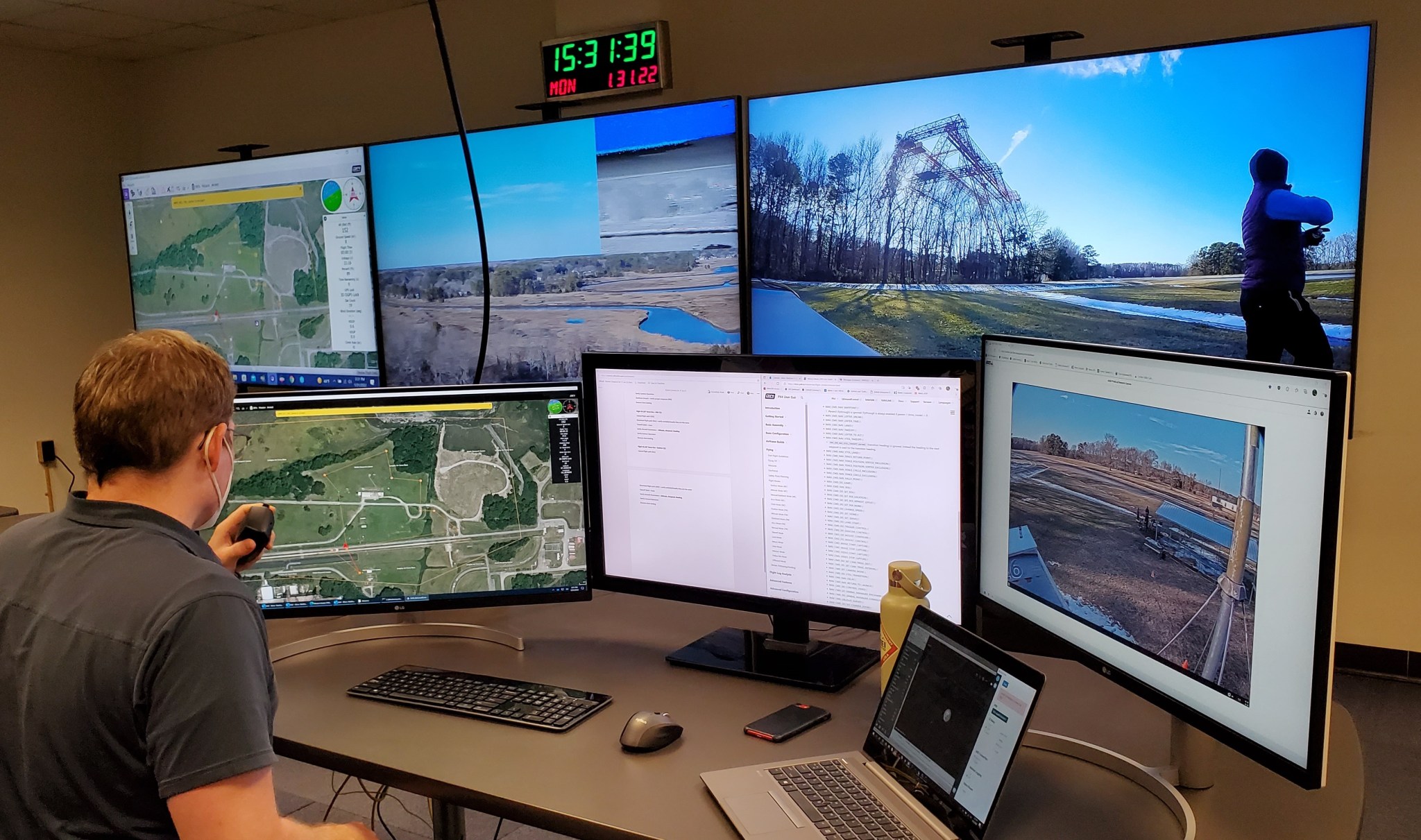It’s common to think of a future where flying autonomous drones complete tasks such as delivering a package to your door. But that only scratches the surface of what’s possible. The coming world of Advanced Air Mobility (AAM) will offer much more to our everyday lives.
Engineers at NASA’s Langley Research Center in Hampton, Virginia, are taking another step towards this reality by demonstrating how unmanned aircraft systems (UAS) can be used to assist in challenging or hazardous tasks such as perimeter surveillance or inspecting large structures.
The first step was to establish a command-and-control center.
Utilizing a recently decommissioned secure office space, team members created the Mission Operations & Autonomous Integration Center or MOSAIC. Personnel inside the MOSAIC – a windowless area located in a building near the center of Langley’s campus – can remotely monitor and control a vehicle flying outside and communicate with test range personnel and air traffic control.
Operators in the MOSAIC can actively monitor all of the vehicle’s performance data, issue commands for controlling the vehicle, and view a live feed of high-definition video streamed to the control room from the vehicle’s onboard camera.
For this mission, the vehicle itself was equipped with advanced autopilot, navigation, and communication systems to enable autonomous flight, safety controls, a gimbal mounted camera, and video transmission.
Following ground testing of the system, the next step was to test the vehicle completely within visual line-of-sight. This means a drone operator has visual contact with the vehicle while controlling or initiating an autonomous flight. This task was accomplished outside at Langley’s City Environment Range Testing for Autonomous Integrated Navigation (CERTAIN) UAS test range.
As a use-case to work with, team members were given the scenario of assisting with perimeter security of Langley Research Center.
The UAS was programmed to fly within a specific area, allowing it to “patrol” a portion of the Center’s perimeter fence line. Its mission: to stream live video to the MOSAIC to allow a human observer to locate anything suspicious.
As the UAS flew along its route, a visual observer located in the MOSAIC was able to ask the vehicle to pause and for the camera to target and zoom in on potential simulated vulnerabilities along the fence line. For this test, the visual observer was a member of NASA Langley’s Office of Protective Services. During the demonstration, the security officer identified areas of interest deemed worthy of further inspection and dispatched a patrol car to investigate the scene.
The live video captured by the UAS was successfully delivered to the MOSAIC and used by security as intended.
“This is not only a great flexing of the technology associated with UAS, but it may ultimately result in cost-savings while also putting more distance between potentially dangerous activities and people, which is always a good thing,” said Jennifer Kibler, project manager for NASA Langley’s CERTAIN Smart Center activity.
Shortly after completing the perimeter surveillance demonstration, the CERTAIN Smart Center team accomplished “extended” visual line-of sight (EVLOS) flights from the MOSAIC. To do this, the drone operator was moved from the field and placed inside the MOSAIC. A range safety officer and trained observers remained outside within visual sight of the vehicle and had the ability to take over control of the vehicle in the event of an anomaly.
“These EVLOS flights serve as an important step toward achieving beyond visual line-of-sight flights (BVLOS) on CERTAIN,” said Kibler. “If we’re going to conduct the groundbreaking research and development activities required to further U.S. leadership in the realm of AAM, it’s very important that we have the ability to conduct BVLOS operations within the airspace above NASA’s research Centers.”
The CERTAIN Smart Center activity will continue to demonstrate the capabilities of autonomous UAS flights with an upcoming inspection of Langley’s Landing and Impact Research Facility, commonly referred to as the gantry.
Standing at 240 feet tall and 400 feet long, the gantry is a large crane structure used to simulate a variety of tests including aircraft crashes and space capsule splashdowns. Performing a structural inspection of the gantry is an expensive and dangerous task. By sending in a small UAS to fly around the gantry and perform a thorough 3D-scan, this autonomous system can reduce both costs and risk to life.
“This is a different lens of aviation safety to me,” said Kibler, “We can use aviation and aviation-related technologies in ways that don’t just keep people safe when they’re flying, but also to assist first-responders and other people in dangerous situations.”
The inspection of the gantry is scheduled to take place in spring of 2022.
David Meade
NASA Langley Research Center






































